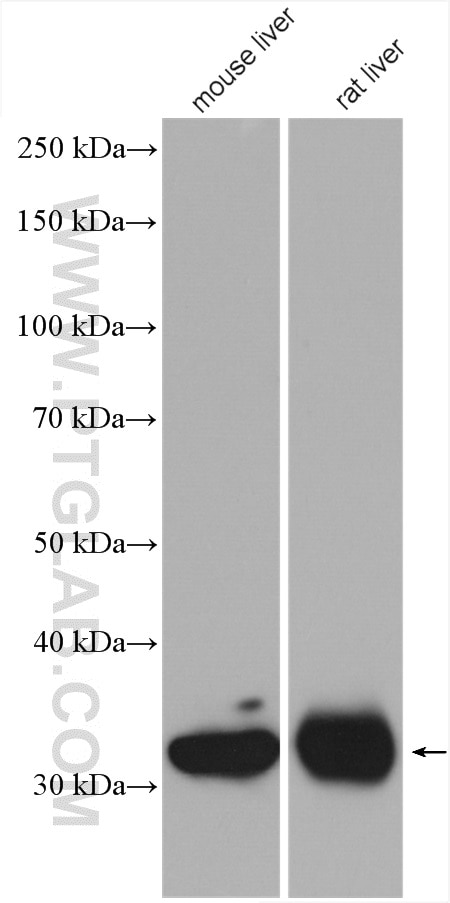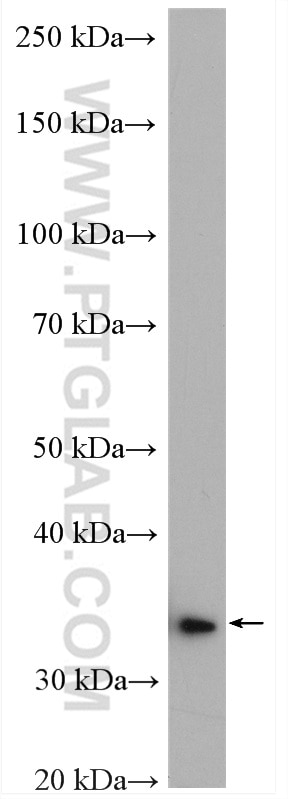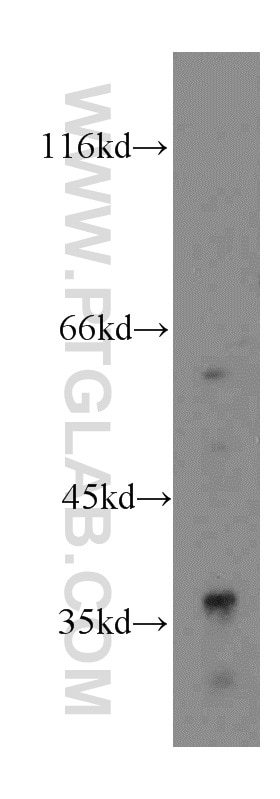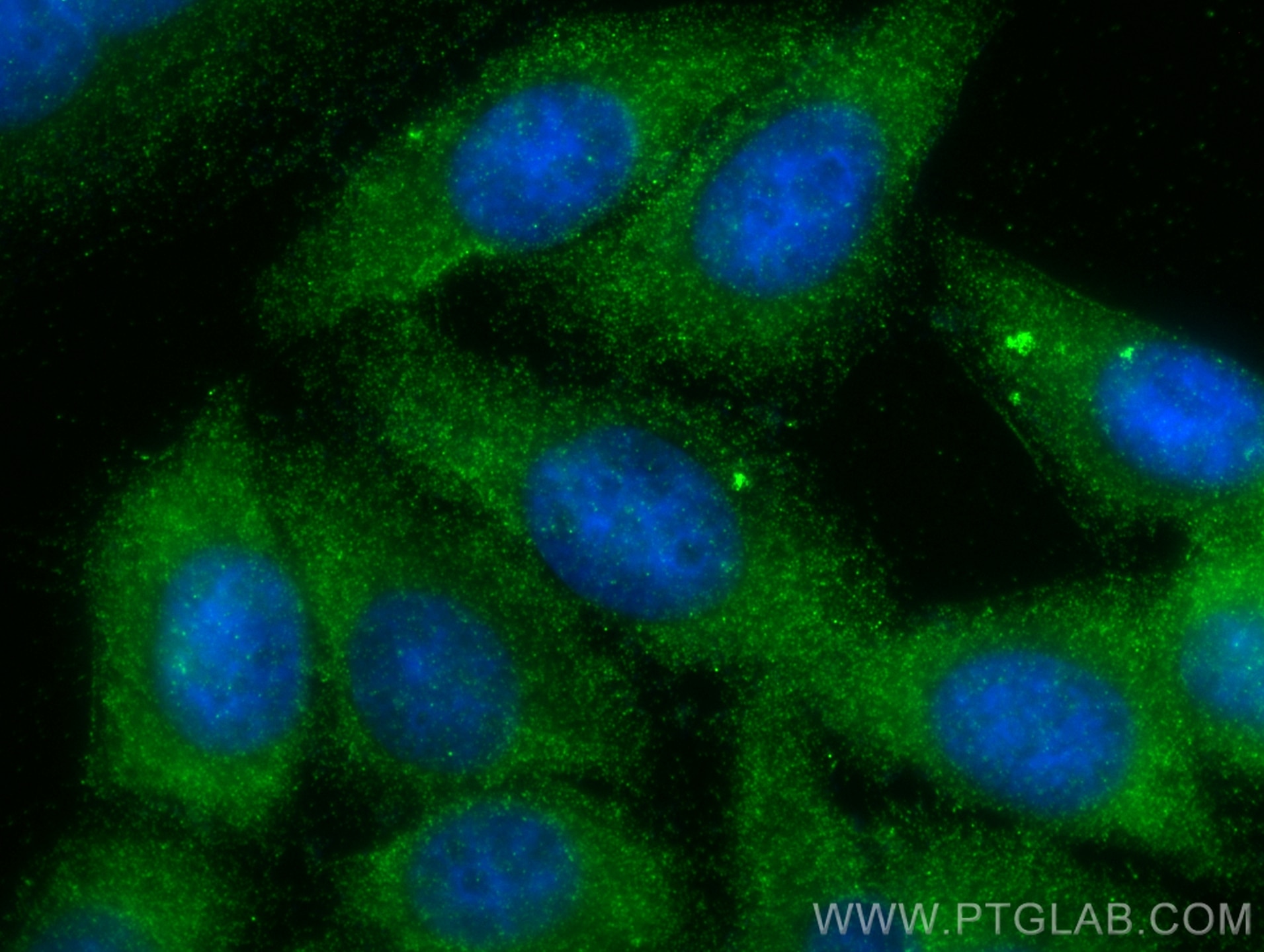Validation Data Gallery
Tested Applications
| Positive WB detected in | mouse liver tissue, HepG2 cells, mouse heart tissue, rat liver tissue |
| Positive IF/ICC detected in | HepG2 cells |
Recommended dilution
| Application | Dilution |
|---|---|
| Western Blot (WB) | WB : 1:500-1:3000 |
| Immunofluorescence (IF)/ICC | IF/ICC : 1:50-1:500 |
| It is recommended that this reagent should be titrated in each testing system to obtain optimal results. | |
| Sample-dependent, Check data in validation data gallery. | |
Published Applications
| WB | See 10 publications below |
| IHC | See 2 publications below |
| IF | See 1 publications below |
Product Information
13451-1-AP targets GPD1 in WB, IHC, IF/ICC, ELISA applications and shows reactivity with human, mouse, rat samples.
| Tested Reactivity | human, mouse, rat |
| Cited Reactivity | human, mouse, rat |
| Host / Isotype | Rabbit / IgG |
| Class | Polyclonal |
| Type | Antibody |
| Immunogen |
CatNo: Ag4278 Product name: Recombinant human GPD1 protein Source: e coli.-derived, PGEX-4T Tag: GST Domain: 1-349 aa of BC032234 Sequence: MASKKVCIVGSGNWGSAIAKIVGGNAAQLAQFDPRVTMWVFEEDIGGKKLTEIINTQHENVKYLPGHKLPPNVVAVPDVVQAAEDADILIFVVPHQFIGKICDQLKGHLKANATGISLIKGVDEGPNGLKLISEVIGERLGIPMSVLMGANIASEVADEKFCETTIGCKDPAQGQLLKELMQTPNFRITVVQEVDTVEICGALKNVVAVGAGFCDGLGFGDNTKAAVIRLGLMEMIAFAKLFCSGPVSSATFLESCGVADLITTCYGGRNRKVAEAFARTGKSIEQLEKELLNGQKLQGPETARELYSILQHKGLVDKFPLFMAVYKVCYEGQPVGEFIHCLQNHPEHM 相同性解析による交差性が予測される生物種 |
| Full Name | glycerol-3-phosphate dehydrogenase 1 (soluble) |
| Calculated molecular weight | 349 aa, 38 kDa |
| Observed molecular weight | 32-42 kDa |
| GenBank accession number | BC032234 |
| Gene Symbol | GPD1 |
| Gene ID (NCBI) | 2819 |
| RRID | AB_10646471 |
| Conjugate | Unconjugated |
| Form | |
| Form | Liquid |
| Purification Method | Antigen affinity purification |
| UNIPROT ID | P21695 |
| Storage Buffer | PBS with 0.02% sodium azide and 50% glycerol{{ptg:BufferTemp}}7.3 |
| Storage Conditions | Store at -20°C. Stable for one year after shipment. Aliquoting is unnecessary for -20oC storage. |
Background Information
GPD1 (Glycerol-3-phosphate dehydrogenase 1) is an important enzyme belonging to the NAD-dependent glycerol-3-phosphate dehydrogenase family. Its C-terminal structural domain contains multiple helical structures for binding the substrate DHAP, and its N-terminal structural domain contains a β-folded core for binding NADH. GPD1 catalyzes the conversion of dihydroxyacetone phosphate (DHAP) and reduced nicotinamide adenine dinucleotide (NADH) to glycerol-3-phosphate (G3P) and NAD+, and plays a key role in carbohydrate and lipid metabolism. GPD1 also works with mitochondrial glycerol-3-phosphate dehydrogenase to form a glycerophosphate shuttle system that facilitates the transfer of reducing equivalents from the cytoplasm to the mitochondria. Abnormal activity of GPD1 has been associated with a variety of metabolic disorders, such as obesity, hypertriglyceridemia, and GPD1 has been implicated in cancer, potentially acting as a tumor suppressor.
Protocols
| Product Specific Protocols | |
|---|---|
| IF protocol for GPD1 antibody 13451-1-AP | Download protocol |
| WB protocol for GPD1 antibody 13451-1-AP | Download protocol |
| Standard Protocols | |
|---|---|
| Click here to view our Standard Protocols |
Publications
| Species | Application | Title |
|---|---|---|
J Hematol Oncol Allosteric activation of the metabolic enzyme GPD1 inhibits bladder cancer growth via the lysoPC-PAFR-TRPV2 axis. | ||
Proc Natl Acad Sci U S A A ferroptosis defense mechanism mediated by glycerol-3-phosphate dehydrogenase 2 in mitochondria. | ||
J Ethnopharmacol Si-Ni-San promotes liver regeneration by maintaining hepatic oxidative equilibrium and glucose/lipid metabolism homeostasis | ||
Mol Biol Rep Glucose enhances catecholamine-stimulated lipolysis via increased glycerol-3-phosphate synthesis in 3T3-L1 adipocytes and rat adipose tissue. | ||
Phytomedicine Radix Astragali decoction improves liver regeneration by upregulating hepatic expression of aquaporin-9 | ||
Int J Biol Macromol Genistein and metformin regulate glycerol kinase and the enzymes of glycerol 3-phosphate shuttle in a differential manner in myocytes, hepatocytes and adipocytes |




